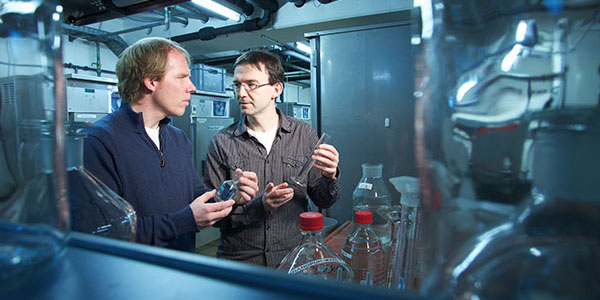Department Environmental Chemistry
Target- and Non-target Screening of Organic Pollutants at the International Monitoring Station of the River Rhine at Basel

The river Rhine and its tributaries are a source of drinking water for more than 20 million people. At the same time treated waste water from numerous industrial sites and from the 54 million people living in the catchment area ends up in the rivers. So, given the need to detect and identify problematic substances as early as possible, it is little wonder that the Rhine is among the world’s most closely monitored river systems. An international net of monitoring stations coordinated by the International Commission for the Protection of the River Rhine (ICPR) was built up along the river. The goal of the monitoring stations is a long-term trend monitoring of selected substances as well as the timely detection of accidental spills. In cooperation with the Federal Office for the Environment (FOEN) and the Office for the Environment and Energy (AUE) of Canton Basel-City (which operates the monitoring station at Basel), Eawag investigated how the latest analytical methods can be used to detect substances in the Rhine not currently covered by monitoring programs.
Trend analysis
In the initial project, a multi-component analytical method developed at Eawag was transferred to the laboratory at AUE Basel-City. The comprehensive method for the measurement of more than 300 Swiss relevant target substances was adjusted for use in a routine lab and has been used daily in the laboratory of AUE Basel-City since January 2012. This implementation was only possible by subsequent optimization and automation of the data processing, for which a new software solution was developed and programmed at Eawag (EnviMass). The results of all measurements in the year 2012 were published in the article “20 years monitoring station Basel” (article in German language with French summary, pdf). Of the 300 targeted substances, 150 were detected at least once per year, about 80 of them regularly. The long lasting and high quality datasets of the daily composite samples at the monitoring station in Basel are to date unique and allow a detailed insight of the organic contamination situation of the river.
Spill detection
A second part of the project focused on the immediate detection and identification of accidental spills. As spills are mostly caused by unknown substances, their detection is very challenging. Key for the detection and identification of unknown organic substances is high resolution mass spectrometry, where accurate mass data are used to determine the chemical composition of unknown compounds. Complementing these data is the fragmentation spectra of selected unknown molecules, which provide structural information of the compounds; together the data can lead to an identification of a specific substance. Most challenging for the spill detection is the rapid processing of the huge amounts of data produced daily by the monitoring network and modern analytical instruments. To handle this, within the last few years several methods were developed and tested at Eawag to efficiently filter and prioritize measured data using intelligent processing algorithms. These procedures were adjusted for daily routine work and have been used since 2014 for monitoring the river Rhine at the international monitoring station in Basel. Since the new methods were implemented, several accidental spills could be detected and even stopped because of an active cooperation between the regional industrial production sites, wastewater treatment plants and local authorities.
The following study published in 2015 investigated the contamination situation of the river Rhine along the whole length, from the lake Constance to the start of the Rhine delta in the Netherlands. In this study not only 300 known target substances were measured but also two methods were presented to successfully detect and identify unknown substances.
